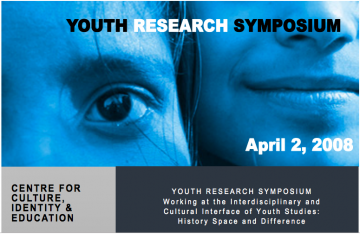Watch: “Learning to Protest: Youth Activist Struggles for Recognition and Symbolic Authority in a Neoliberal Moment” by Jackie Kennelly
This paper explores the material effects of an array of cultural and subcultural forces on three groups of urban Canadian young people: youth activists in Toronto, Montreal, and Vancouver. The main argument of the paper is that histories of liberal discourses, symbolic and material forms of racism, colonialism and class conflicts, as well as the contemporary ascendancy of neoliberalism, have created a specific cultural space that have identifiably shaped youth activist subcultures in Canada. The paper builds this argument on the basis of a year-long ethnography with 38 young people (ages 13-29) engaged in youth activist subcultures contesting globalization, war, poverty, and/or colonialism across Canada’s three largest cities. In the first section of this three-part exploration, I consider the influence of liberalism and neoliberalism, reading the pressures faced by young activists through the lens of these two ideological forces.
Watch: “The Nexus of Youth Studies and Gender Studies: Questions of Methodology” by Lisa Loutzenheiser
This paper explores the theoretical and methodological issues surrounding researching with, for, and about queer youth in ways that trouble youth identities that are represented in the wider social contexts. The primary lens of the paper is an examination of (hetero)normativity and the possibilities of queering qualitative methodologies. Opening with a brief contextualization of the ethical conundrums inherent in a qualitative research methodology, I am particularly interested in methodologies that emanate from epistemologies that attempt both to be ethical, and to acknowledge the very impossibility of such a move.
Watch: “Interrogating Identities: Exploring Racism, Community and Belonging Among Mixed Race Youth in Canada” by Leanne Taylor
he past two decades have witnessed large, international shifts in the ways in which mixed race identity, experiences, and perspectives have been addressed and understood. Historically portrayed as tragic and confused, mixed race individuals are increasingly being celebrated and featured in a range of new settings. For example, new media such as mixed race blogs, websites, Facebook groups, as well as other emerging products such as dolls, toys, and books documenting experiences of growing up ‘mixed’, are all new resources from which many of today’s young multiracial population can draw. Mixed race youth are not only participating in these venues, but are increasingly becoming their creators. In this paper, I explore a set of Canadian texts and new media in which mixed race youth narrate their experiences. I suggest that the ideas coming out of those conversations offer an important critique of contemporary discussions of not only racial identity construction, but of discourses on youth identity.
Watch: “Navigating the Pedagogy of Failure: Medicine and Education Encounters: The Disabled Child in English Canada, 1900-1945” by Mona Gleason
At the turn of the twentieth century, medical and educational professionals in numerous national contexts solidified their relationship as partners against the challenges posed by disabled children. In the United States, as was the case in much of Western Europe, eugenic thinking suggested that biological solutions provided answers to social problems posed by ‘abnormal’ bodies. While American and British contributions to the fate of children labeled disabled over the twentieth century have garnered scholarly attention, the English Canadian experience suggests additional, yet often overlooked, affinities. Physical and mental ‘defectives’ or ‘cripples,’ as they were described in the context of the time, were judged largely ill-suited to the demands of public schooling, particularly as it was conceived and configured before World War II in English Canada. Yet, even by the 1920s, manual training was held out as a possible solution to the ‘management’ of the young ‘mentally defective,’ as numerous medical and educational professionals suggested. While children with physical impairments caused other kinds of social anxieties, English Canadian professionals engaged in similar patterns of hand wringing over their fate as well
Watch: “Morality Squads, Curfews, and the Sports Solution: Policing Youth in Mid-Twentieth Century Canada” by Tamara Meyers
This paper speaks to the symposium’s main aims of “rethinking conceptualizations of marginalized youth identity” and of exploring “the history of policing and surveillance of young bodies over time and across national spaces” through an examination of a watershed moment in the history of policing youth in Canada. Faced with a deepening public crisis over youth in the 1940s Canadian police forces invented new technologies of surveillance and discipline and in turn reshaped their role in the juvenile justice and child welfare systems. Focusing on Montreal, this paper investigates critical developments in urban policing including fresh ventures like the creation of the Juvenile Morality Squad (later the Delinquency Prevention Bureau), a juvenile nocturnal curfew, and the Police Juvenile Club. It charts the work of male and female officers as they enforced juvenile curfew regulations and launched the ‘Sports Solution’.
Watch: “Dark Matter: Race, Religion and Youth in Global Times” by Anoop Nayak
This paper examines the complex articulation of race, religion and citizenship in the light of urban unrest in Britain in 2001, the destruction of the Twin Towers later that year and the aftermath of the London bombings in 2005. It considers the contradictory ways in which Muslim youth, asylum-seekers and minority ethnic young people are positioned in the post-9/11 landscape.
Watch: “Hello Kitty: The Work of Nature in the Age of Digital Communication” by Dr. jody Berland
The featured speaker is Dr. jody Berland, York University. In this presentation, Dr. Berland addresses the increasing visibility of animals in contemporary image culture and how such images are so closely aligned with the signs and practices of technoculture.
Watch: “Creating a Multicultural Nation: The Educational Role of Media” by Professor Ien Ang
The featured speaker is Professor Ien Ang, University of Western Sydney. In this presentation, Professor Ang explores the constructive role that media can play in promoting the creation of a multicultural nation.


